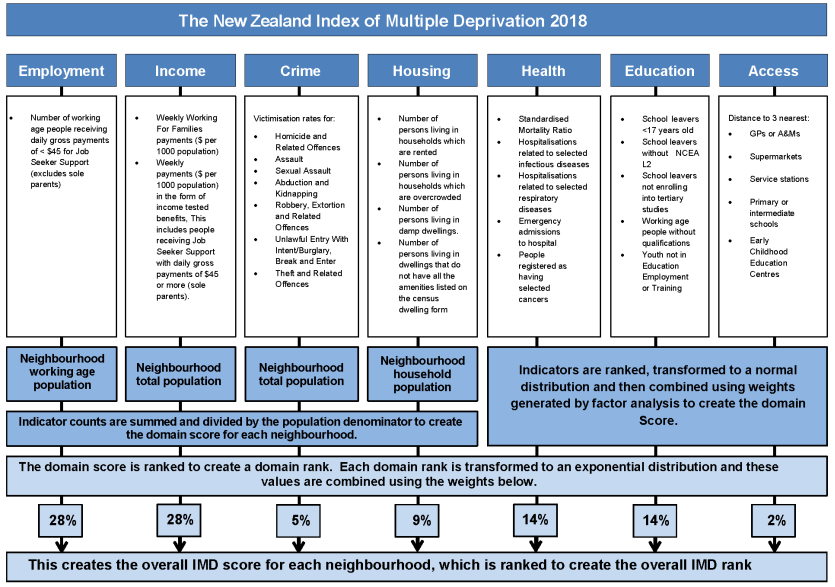New Zealand Index of Multiple Deprivation (IMD)
The IMD project won the People & Community section of the 2018 New Zealand Spatial Excellence Awards. Check out the video (3:46) that we entered for the awards.
2018 New Zealand Index of Multiple Deprivation (IMD18)
The 2018 New Zealand Index of Multiple Deprivation (IMD18) is a set of tools for identifying concentrations of deprivation in New Zealand. The IMD18 comprises 29 indicators grouped into seven domains of deprivation: Employment, Income, Crime, Housing, Health, Education and Access to services. IMD18 is the combination of these seven domains, which may be used individually or combined. The same methods used for IMD13 were used in 2018, however, we added two indicators (household dampness and household amenities) to the Housing Domain. Figure 1 shows the 2018 IMD’s 29 indicators and seven domains. The 2018 New Zealand Index of Multiple Deprivation was funded by the Auckland Medical Research Foundation.
IMD18 measures deprivation at the neighbourhood level in custom-designed 2018 data zones that have an average population of 761. Data zones are designed to produce better small area information without losing their contents to suppression or confidentiality. The New Zealand land mass was divided into 6,181 data zones (DZ) in 2018, which mostly nest within 2013 data zone boundaries. Some of the 2013 data zones had low populations in 2018, so were merged with adjacent areas, while those areas that experienced a population increase between 2013 and 2018 were split to maintain relatively consistent populations. No 2018 meshblocks were split. Combining was not possible for 49 data zones with very low populations (ranging from 399 to 499) due to unsuitable neighbouring data zones, and splitting was not possible for 2 data zones with very high populations (1272 and 1284). On average, there are 8.55 meshblocks per data zone.

Figure 1. Developing the 2018 NZ Index of Multiple Deprivation: An overview of indicators, domains and weights. Adapted from Figure 4.2 SIMD 2012 Methodology, in Scottish Index of Multiple Deprivation 2012. Edinburgh: Scottish Government (Crown copyright 2012).
2013 New Zealand Index of Multiple Deprivation (IMD13)
The 2013 New Zealand Index of Multiple Deprivation (IMD) is a set of tools for identifying concentrations of deprivation in New Zealand. It measures deprivation at the neighbourhood level in custom-designed 2013 data zones that have an average population of 712. Data zones are aggregations of census meshblocks (approximately 8 meshblocks per data zone) and in urban settings they are just a few streets long and a few streets wide. They are designed to produce better small area information without losing their contents to suppression or confidentiality.
The IMD uses routinely collected data from government departments, census data and methods comparable to current international deprivation indices to measure different forms of disadvantage. It is comprised of 28 indicators grouped into seven domains of deprivation: Employment, Income, Crime, Housing, Health, Education and Access to services. The IMD is the combination of these seven domains, which may be used individually or in combination to explore the geography of deprivation and its association with a given health or social outcome. Figure 1 shows the IMD’s 28 indicators and seven domains with their weightings.
The Index of Multiple Deprivation was developed by the IMD team: Dr Daniel John Exeter, Dr Jinfeng Zhao, Dr Sue Crengle, Dr Arier Chi Lun Lee and Michael Browne, with help and support from numerous individuals and organisations.